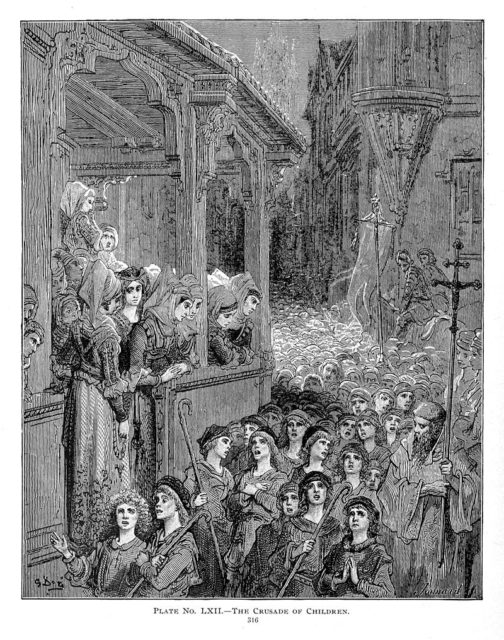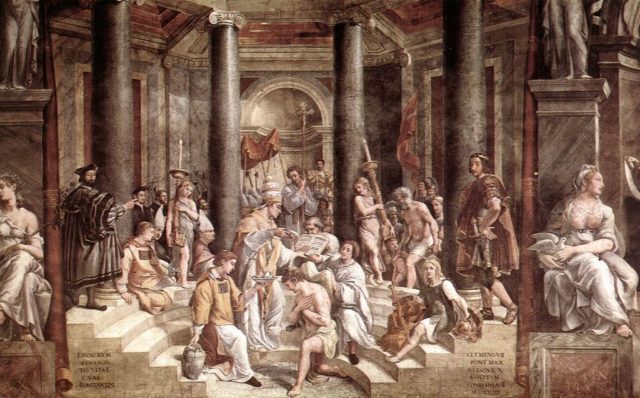The Crusades are some of the most famous historical events. They were a series of military campaigns from Medieval England and Europe against the Turks and other peoples who lived near Jerusalem.
These wars were to last for nearly 200 years and many, many lives were lost. However, throughout the duration of the Crusades some blunders were made, and here are the ten worst of these.
10. Destruction of the Knights Templar

This was a military order dedicated to the cause of the Crusades. Individual Templars were to be poor and pious, but the order as a whole soon became wealthy and powerful. The Templars created modern banking with a system where pilgrims could deposit money in Europe and withdraw the deposit in the Middle East, making the journey a bit safer from robbers. However, King Philip IV of France wanted their funds for himself and so, in turn, convinced Pope Clement V that the Templars had become heretical and corrupt. Across Europe, Templars were arrested and their goods seized; they were then executed. Many were burned at stake.
9. Children’s Crusade
This was an unsanctioned crusade made up of peasants; it consisted of children, teenagers, women, the elderly, and the poor. It was organized and led by a young man called Nicholas of Cologne.
The fate of this crusade is unclear, as is the fate of its leader. It is known that they reached Genoa in 1212.

The seas did not part for them as expected, so some of the peasants stayed and worked in the area while others made their way on to Rome and beyond. Nicholas’s father was made an example of by the parents of the missing children and was hung while they were gone. Many who took part in these crusades went missing, and it is suspected that they were enslaved.
8. King Richard Lionheart fails to marry off sister
The Third Crusade, which took place from 1189 to 1192, had two great notables. The first was the King of England, King Richard the Lionheart, and the second was Saladin, the Kurdish Sultan. Wishing to win the war without any more losses, King Richard decided to marry off his sister Joan to Saladin’s younger brother, al-Adil.
The sultan did not take the offer of the alliance seriously, which is good because when Joan found out, she was quite upset at her brother. There was no way she would marry a Muslim, and there was no way her husband-to-be would convert to Christianity.

Richard tried to get a niece to agree to the marriage, but this plan fell through also. Eventually, a peace agreement was brokered with Saladin, and Richard was able to return home.
7. Fleeing Oath Breakers
Fear was the major reason many people did not make it onto the crusades. Fear also caused many already there to return home, especially when the failure of the First Crusade was in many peoples’ minds.
Europe turned en masse on these oath breakers when the crusaders actually did manage to take Jerusalem; the Pope at the time was going to excommunicate anyone who had taken a vow but hadn’t gone or had returned unbloodied.

The crusaders in Jerusalem desperately needed help to hold the city and many families took it on themselves to push out the oath breakers from their homes. It was the only way the shame could be lifted, and many of the oath breakers set back out on the road and re-joined the crusade. Unfortunately for these people, the Crusade of 1101 was a complete failure, and many of them lost their lives.
6. The Greed of Frederick II, King of Jerusalem

Frederick II was an intelligent ruler and was King of Germany, King of Sicily, Duke of Swabia, and was the Holy Roman Emperor. However, he was unreliable and had a habit of making empty promises – one too many of these he made to the Pope and so he was excommunicated. The Pope had been trying to see him off on a church-sanctioned crusade, but this never materialized due to various excuses. However, once he was excommunicated Frederick decided this was a perfect time to head off on a Crusade of his own.
His plan was to grow his power and land holdings, and his first success was with Malik al-Kamil of Egypt. He received Jaffa, Bethlehem, Nazareth, and Jerusalem – this was the start of a 10-year truce. This is when Frederick decided he was King of Jerusalem, a title that was rejected by the Catholic Church and European nobility. He was excommunicated again. Eventually, the treaty expired, and the lost places were retaken.
5. Byzantine Empire usurped by Crusaders

The Byzantine Empire was a powerful Christian state of the middle ages, but it could not withstand the Muslim attacks from the south and east. Emperor Alexius I pleaded for help from Pope Urban II, and this became one of the sparks that created the First Crusade. An issue developed between the two friendly sides, as the Byzantines were Greek Orthodox and the feudal lords of Europe were Roman Catholics. There was no trust between the two sides, and it culminated in crusaders keeping recaptured land as the Byzantines let the crusaders fend for themselves. This went on for many years until the Fourth Crusade in 1202. Crusades had become very expensive, and now lords were looking for ways to fund their journeys. At the time, the Byzantine prince Alexius IV had lost out on his heirship to the throne due to his uncle usurping his father.
The crusaders made a deal that if they got him on the throne, he would fund the Venetian crusade. Unfortunately, the new Emperor couldn’t actually pay for the crusade. The crusaders turned on him and his family and sacked Constantinople in 1204, installing their own Western European Emperor.
4. Crusader Cannibalism in Syria

In 1098, during the First Crusade, the crusaders besieged and conquered a city in Syria called Ma’arra. The residents surrendered a month after the siege and were promised that they would be unharmed by the invaders. Unfortunately, the crusaders had lied and the people in the city were slaughtered. Then the crusaders discovered that the food stores in the city were too low to support them, in desperation they did the unthinkable and began to eat the dead residents. Reports were even written to the Pope describing the conditions in this city and the barbaric behavior of the crusaders.
3. King Louis and the Dysentery
The seventh Crusade was initiated by King Louis IX of France, one of the few remaining monarchs who still had some belief in the crusades.
He chose to attack Egypt, but the campaign ended up failing; the King was captured, ransomed, and made to flee back to Europe.

Not to be deterred, Louis decided to have another go fighting for Christendom in 1270. He thought that by getting a foothold in Tunisia, he would find it easier to attack Egypt again. However, when he and his army landed in Africa things did not go quite to plan. A large proportion of his army and Louis himself caught dysentery. Louis died in August that year.
2. Violent Anti-Semitism as sideline for Crusaders

The church-sanctioned targets of the Crusades were the Muslims in the Middle East. However, the Crusades also sparked some of the earliest cases of violent anti-Semitism.
As they traveled, the crusaders rationalized that Jews were also enemies of Christians. Despite Papal commands, some groups broke off course and started attacking the Jewish communities in both Europe and the Middle East. In 1096 crusaders attacked prosperous and peaceful settlements on the Rhine and gave their victims a choice to convert or die. Many Jews killed their own families rather than convert. The Jews living in Jerusalem in 1099 when the crusaders took it became slaves and were forced to clean the city. Every time a crusade started, a new wave of death swept over the Jews. It is known that the Crusades were responsible for the destruction of over 100 Jewish communities and caused thousands of senseless deaths, Listverse reported.
1. Mega-Pastor Paul Flees the Crusades
Peter the Hermit, from Amiens, France, was someone who heard the call for battle against the Turks very loudly and clearly. With his eloquent speeches and enthusiasm, he soon rallied a huge following and became an outspoken advocate for the First Crusade. He became a mega-pastor and in 1096, led his followers to war. He arrived before the main crusading armies, and his troop of peasants grew out of hand and, against all advice, dove in to deal with the Turks.
Peter was in Constantinople when his troops were killed, unaware that they had taken matters into their own hands.

He had no choice but to wait to join the main force when it arrived in Constantinople. The First Crusade was bloody and messy. Unable to cope with it anymore, Peter fled in 1098.
Read another story from us:Crusader-era hand grenade found in Israel
He was captured by crusaders who prompted him to beg for forgiveness and return to the battle.
